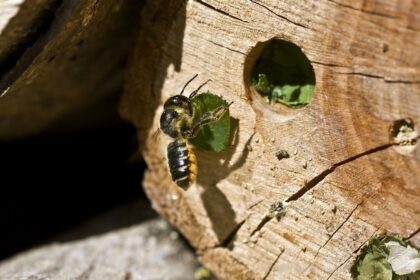
For those of us who observe the academic calendar in the United States, the end of August means the end of summer and the beginning of a new year. It’s a time of general excitement and new possibilities. And while we are caught up in the craziness that comes during this season, we are generally unaware that winter is coming – at least for those that live in the northern hemisphere. Somehow, even though I know it is coming, I am never quite prepared for its arrival. My unpreparedness is partly because day-to-day busyness distracts me from these sorts of things, but there are other reasons. One is that the timing of seasons is changing and becoming less predictable because of global climate weirding. Another reason is that modern lighting, heating and cooling systems, and agricultural practices have lessened the need to prepare for seasonal changes in daylight, temperature, and food abundance.
I am fully aware that not all living things (or even all people) share the privilege I have of paying more attention to holiday seasons or sports season than to seasons marked by significant changes in average daily temperatures and food availability. Most living things have little control over their surroundings, and they rely on a variety of adaptations in order to survive seasons when the environment is inhospitable. Insects, birds, reptiles, mammals, and plants that live in temperate regions adjust their metabolic rates, behaviors, activity levels, living spaces, and, in some cases physical appearances in order to survive the challenges of winter. Some birds, insects, and mammals escape from winter by migrating to warmer places with a more hospitable climate. Other living things shelter in place in some form of suspended animation.
Many insects fit into this second category, and they overwinter in diapause, a type of dormancy that is similar to, but not exactly like, hibernation. One key difference is that diapause is an anticipated response and requires a period of preparation in order to make it through. Diapause is initiated by an environmental cue (e.g., change in daylength or food quality) that activates the switch to begin accumulating fat stores, finding a sheltered place, and other necessary preparations. The specific changes that occur during diapause are unique for each type of insect. And this includes the timing of diapause within the insect’s lifecycle (i.e., the egg (embryo), larval, pupal, or adult stage).
For insects that enter diapause as embryos, it is the mother that detects the coming change in the environment and initiates a diapause program that will take effect in her offspring. This maternal regulation of is well studied in some locusts, crickets, and mosquitoes. The best studied example is probably the domestic silk moth, Bombyx mori. Females detect a change in the environment while they are still embryos themselves and, through a currently unknown mechanisms, store that information into adulthood. When a female becomes is a mature adult, her brain releases a diapause hormone that signals to her ovaries that she needs to increase the amount of sorbitol (a type of sugar alcohol) that she puts into her eggs. Ultimately it is the sorbitol that causes developmental arrest and initiates diapause during the embryo stage of her offspring.

9Which of you, if your son asks for bread, will give him a stone? 10Or if he asks for a fish, will give him a snake? 11If you, then, though you are [insects], know how to give good gifts to your children, how much more will your Father in heaven give good gifts to those who ask him! 12So in everything, do to others what you would have them do to you, for this sums up the Law and the Prophets. (Modified from Matthew 7: 9-12, NIV)
Maternal preparation for diapause is just one way that insect mothers care for their offspring and provide for their future. Tsetse fly mothers produce, and feed, a milky substance to their larvae. Earwig mothers clean microbes from their eggs, defend their nymphs from predators, and provide food. Carrion beetles, the oldest known example of parental care, provide carrion for their young either passively by ovipositing near a suitable carcass or actively through food secretions. Some solitary bees, like alfalfa leafcutting bees, build nests for their young that they line with cut leaves and provision with balls of food made from nectar and pollen. Even insect mothers that don’t stick around (or live long enough) to actively care for their offspring often provide for them by selecting a location to oviposit (lay their eggs) where their offspring have the good chance of surviving.
To summarize, even insect mothers help their progeny prepare for coming changes in the environment, and this is just one way that insects provide care for their many offspring. My hope is that you enjoyed learning about maternal regulation of insect diapause and insect maternal care in general. I also hope you now have a new appreciation for insects and the amount of maternal effort that goes into providing for the next generation. Mostly I hope that, just maybe, you take away a connection between how insects care for their young behind the scenes and the way God cares for us behind the scenes even when it isn’t obvious.
Dr. Julie A. Reynolds is a Research Scientist at The Ohio State University in the department of Evolution, Ecology, and Organismal Biology. She studies insect physiology and biochemistry with the goal of learning how animals adapt to extreme environments and survive changes in climate. In addition to writing for the Emerging Scholars Network, she is actively engages in discussions about science and faith as a Sinai and Synapses Fellow.

Leave a Reply